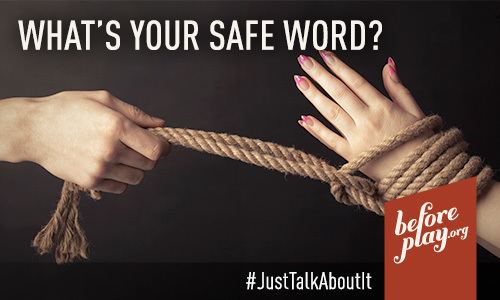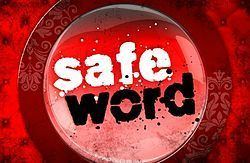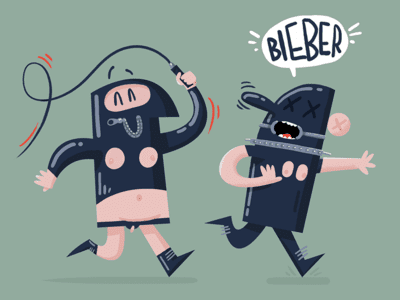 | ||
In BDSM, a safeword is a code word, series of code words or other signal used by a submissive or bottom to unambiguously communicate their physical or emotional state to a dominant or top, typically when approaching, or crossing, a physical, emotional, or moral boundary. Some safewords are used to stop the scene outright, while others can communicate a willingness to continue, but at a reduced level of intensity. Safewords are usually agreed upon before playing a scene by all participants, and many organized BDSM groups have standard safewords that all members agree to use to avoid confusion at organized play events.
Contents

Safewords of BDSM fall under the guiding philosophy of safe, sane and consensual. Those who practise the more permissive philosophy of risk-aware consensual kink may abandon the use of safewords, especially those that practice forms of edgeplay or extreme forms of dominance and submission. In such cases, the choice to give up the use of safewords is a consensual act on the part of the bottom or submissive.
Usage

Safewords are usually used by the submissive, but can be used by all participants in a scene, including tops, dungeon masters at play parties, and sometimes even observers. For example, a submissive may misbehave intentionally to indicate the desire for harsher treatment, and sometimes a top will need to safeword the scene to let them know it has gone too far for the top to continue the scene. Or, a third party observing a scene may have the ability to spot something dangerous going on that both the top and submissive have missed, and need to stop the scene to point it out.
Forms of safewords

A safeword makes it possible for a submissive to say "No" or "Stop" and pretend as much as he or she wants without really meaning it while still having a safe way of indicating they seriously need the scene to stop. In theory a safeword is usually a word that the person would not ordinarily say during sex, such as pineapple, velociraptor, or teacup. With the range of safewords in common use it is important that the safeword be negotiated beforehand.

Since a scene may become too intense for a submissive partner to remember what the safeword is, in practice commonly the words safeword or red are also used as safewords. They are often the default at many play parties, or respected as a safeword in addition to any negotiated safeword. A dungeon monitor would likely expect either of those words to be respected.
Some partners may also have different gradations of safewords, such as green to mean "Okay" or even "harder" or "more", yellow to mean "slow down" or "stop doing that" without stopping the scene, and red to mean "stop the scene". In this fashion, a dominant partner may ask the submissive partner "What is your color?" to check with a submissive partner without having to stop the scene.
In other circumstances the safeword may not be a "word" at all, which is very useful when the submissive is bound and gagged. In these instances a signal such as dropping a bell or a ball, the snapping of fingers, or opening and closing both hands repeatedly or making three clear and rhythmic grunts as a pre-defined signal to stop or otherwise slow down the scene. There is also a convention of tops to put a finger in the "submissive's" hand as a sort of "check in" when the "submissive" has become non-verbal, such as may happen as they reach subspace. In this scenario the "submissive" squeezes the "top's" finger to indicate OK.
Effects of use
A red safeword is only used when one of the partners needs it to end a scene. Many submissive partners may see the use of a safeword as being weak, and will push themselves past their "comfort" zone to please their partner. This may allow a submissive partner to expand their boundaries and learn what they are capable of but may also expose them to risk if they are pushed too far. Additionally, many dominant partners may interpret the use of a safeword as a failure on their part, i.e., failing to understand body language, to know their partner, or loss of control. This is also why gradations of safewords and/or actions that signify a scene may be becoming too much are commonly used (i.e.,Yellow) so that the partners can safely adjust the scene before crossing boundaries.
It is considered important in many parts of the BDSM community that the use of safewords should remain "no-fault" so that participants feel encouraged to use it if necessary. Discouraging the use of safewords runs the risk of scenes becoming non-consensual, harming trust between partners and potentially damaging to their mental and emotional state.
A top will often sensibly make clear beforehand that they will not agree to a scene if they do not believe the submissive will use the safeword as soon as they need to, and the submissive will not delay using the safeword and endure more than they really want to, simply to avoid disappointing the top, since the top will be far more upset if they unwittingly inflict psychological trauma. In addition, intentionally disregarding the activation of a safeword is considered a serious ethical violation.
While many in the BDSM community consider safewords to be an essential part of safe play, there is a contingent that chooses to occasionally play without using safewords. They rely on the dominant partner to monitor the condition of the submissive partner and stop if necessary, at their discretion. In such circumstances the "sub" or submissive must have consented not to have control over the duration of the scene in advance; this is often referred to as consensual nonconsent. Also, some people who routinely play with each other may agree to stop using safe words because they know each other's boundaries and are able to read each other's body language well. In any case "consensual nonconsent" is risky and advanced activity.
"Consensual nonconsent" may also occur if the top and the submissive are reenacting a punishment scene (e.g. a shipboard flogging) in which the offender, played by the submissive, is sentenced to receive a certain number of lashes as punishment. Since the offender would not be able to use a safeword in such circumstances, the parties reenacting the scene agree that it would be "out of character" for them to do so.
